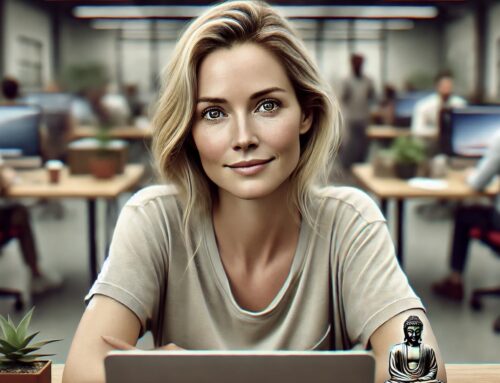Conflict is often seen as a negative force—something to be avoided or minimized. However, Jennifer Jones-Patulli, a seasoned conflict management expert, challenges this perception. She suggests that conflict, when engaged with constructively, can be a powerful driver for creativity and growth. Conflict is not just about interpersonal disagreements but about navigating and harnessing tensions within systems, whether in personal relationships, organizations, or larger societal frameworks. Jones-Patulli encourages us to reframe our understanding of conflict and to view it as a natural, inevitable aspect of human interaction that holds immense potential.
Key Takeaways
- Conflict should be viewed as an opportunity for growth and creative potential rather than merely a source of tension or disruption.
- Understanding and addressing the underlying assumptions and positions in any conflict is crucial for transforming tension into productive outcomes.
- Self-awareness and empathy, balanced with clear boundaries, are fundamental for engaging in productive conflict within interpersonal, organizational, and relational settings.
“Conflict can be an amazing creative force in your life. If you engage with it in a certain way,” says Jones-Patulli.
To effectively navigate conflict, one must first understand what it truly represents: tension in a system. This tension holds potential energy that, depending on how it is handled, can either drive forward momentum or lead to collapse.
Self-Awareness: The Foundation for Navigating Conflict
The Importance of Knowing Yourself
One of the fundamental principles in engaging with conflict productively is self-awareness. Jones-Patulli emphasizes that understanding your own identity, values, needs, and triggers is crucial for turning conflict into a constructive experience. This self-knowledge enables you to approach conflict with clarity about your intentions and desired outcomes.
“The introspection has to be so profound to lean into the productive or creative potential of conflict,” she explains.
For leaders, in particular, this self-awareness translates into the ability to navigate negotiations and conflicts within their teams and organizations more effectively. By starting with a deep understanding of who they are and what they stand for, leaders can create environments where conflict becomes a catalyst for innovation and growth rather than a source of disruption.
Practical Tips for Self-Preparation
Jones-Patulli advises practical steps such as meditation, ensuring adequate rest, and self-reflection before engaging in conflict. These practices help stabilize your emotional state and prepare you for the uncertainties ahead.
“When I was preparing people for mediation settings, it was always about, try to eat well, try to sleep well, get hydrated, do something for yourself to relax you as best you can.”
By aligning internal states with external actions, individuals are better equipped to approach conflict with a calm, composed demeanor, ready to turn tension into an opportunity for constructive dialogue.
The Dynamics of Empathy and Boundaries
Balancing Empathy with Clear Boundaries
Empathy plays a crucial role in conflict resolution, allowing individuals to understand and relate to the emotions of others. However, Jones-Patulli warns against the dangers of excessive empathy, which can lead to emotional manipulation and unhealthy dynamics.
“Empathy is both a power and something that’s going to take you out for sure,” she states.
Establishing clear boundaries is essential to ensure that empathy does not become a tool for manipulation. This balance allows individuals to remain compassionate while also maintaining their own integrity and needs within the conflict.
Recognizing and Addressing Emotional Manipulation
Jones-Patulli highlights the importance of identifying and addressing emotional manipulation within conflicts. This involves being aware of when empathy is being used as a tactic to stall or derail constructive dialogue.
“We can hear something and we can give people the benefit of the doubt, or we can give them space to have an emotion. But also it can lean into the negative side, which is emotional manipulation.”
By recognizing these patterns, individuals can maintain the integrity of the conflict resolution process, ensuring that it remains productive and forward-looking.
Transforming Conflict into a Strategic Process
Engaging in Strategic Conflict
Jones-Patulli advocates for a strategic approach to conflict, emphasizing the importance of timing and positioning. Conflict is not a one-size-fits-all scenario; it requires a nuanced understanding of when and how to engage.
“It’s so strategic when we engage, when we disengage. It’s so strategic how we connect and disconnect,” she notes.
This strategic approach involves assessing the level of conflict, understanding the stakes, and determining the appropriate level of engagement. It also means being clear on whether the conflict in question is transactional or relational—a distinction that significantly influences the approach.
Utilizing Questions and Assumptions
Effective conflict resolution often begins with turning assumptions into questions. This approach fosters a more open, curious, and collaborative dialogue, paving the way for mutual understanding and creative solutions.
“Assumptions can be great, but also they can be quite antagonistic. And some of that is the way you ask the question in the physical world. And some of it is the energy you feel when you’re asking the question.”
By reframing assumptions into questions, individuals can create a space for productive dialogue that explores underlying tensions and seeks collaborative solutions.
Navigating conflict requires a balance of self-awareness, empathy, and strategic engagement. It’s about transforming tension into a constructive force that drives growth, innovation, and deeper understanding.
By approaching conflict with a mindset geared towards creativity and collaboration, we can unlock its potential as a powerful catalyst for positive change. This requires not only understanding the dynamics of conflict but also cultivating the skills and mindset necessary to navigate it effectively.
In essence, conflict is not something to be feared or avoided but rather an inherent part of human interaction that, when engaged with thoughtfully and strategically, can lead to profound personal and collective growth.
Connect with Jennifer Jones-Patulli on LinkedIn
Visit Jennifer’s website: https://productiveconflict.us/
Written by : Brad Hook
Brad Hook is a writer, podcaster, speaker and entrepreneur. He helps individuals and teams achieve sustainable high performance through inspiring workshops and a powerful suite of digital tools. Discover his new book, Start With Values (Penguin Random House), — available now!
Stay connected with Brad
BE NOTIFIED ABOUT EVENTS and receive the latest tools and tips first
We will never share your email with others.






